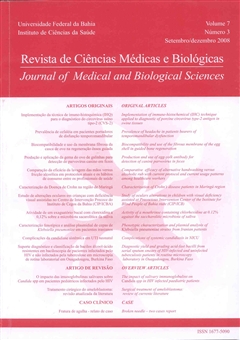Biocompatibility and use of the fibrous membrane of the egg shell in guided bone regeneration
DOI:
https://doi.org/10.9771/cmbio.v7i3.4462Keywords:
Biocompatibility- Eggshell fibrous membrane, Guided bone regeneration.Abstract
The guided bone regeneration technique (GBR) is based on the same principles of the guided tissue regeneration (GTR) and protects an osseous injury from cells deriving out of connective and/or epithelial tissue, by means of a membrane or barrier. The objective of this study had been to research biocompatibility of the “in natura” eggshell fibrous membrane (EFM) sterilized by autoclave to use it as a permanent membrane for the RBG technique. The experiment had thirty Rattus norvegicus albinus in group I and fifteen in group II. The rats from group I had been used to check for biocompatibility, and the ones from group II to evaluate the membrane or barrier. Both groups had subgroups (1, 2, 3 and 4, 5, 6) for experiment and sham, which were evaluated respectively in one, two and three weeks. The results allow us to assert that the EFM is biocompatible according to the infiltrate of plasma cells and lymphocytes absence in the tissues and that it works as a barrier, as evidenced in the osseous production, despite the statistically non significant results between the groups control and sham p=0,257, p=0,317 and p=0,317, respectively for one, two and three weeks, through Wilcoxon´s test.Downloads
Download data is not yet available.
Downloads
Published
2008-02-18
How to Cite
Oliveira, M. Q., Santana, E. J. B. de, & Sadigursky, M. (2008). Biocompatibility and use of the fibrous membrane of the egg shell in guided bone regeneration. Journal of Medical and Biological Sciences, 7(3), 228–240. https://doi.org/10.9771/cmbio.v7i3.4462
Issue
Section
ORIGINAL ARTICLES
License
The Journal of Medical and Biological Sciences reserves all copyrights of published works, including translations, allowing, however, their subsequent reproduction as transcription, with proper citation of source, through the Creative Commons license. The periodical has free and free access.


